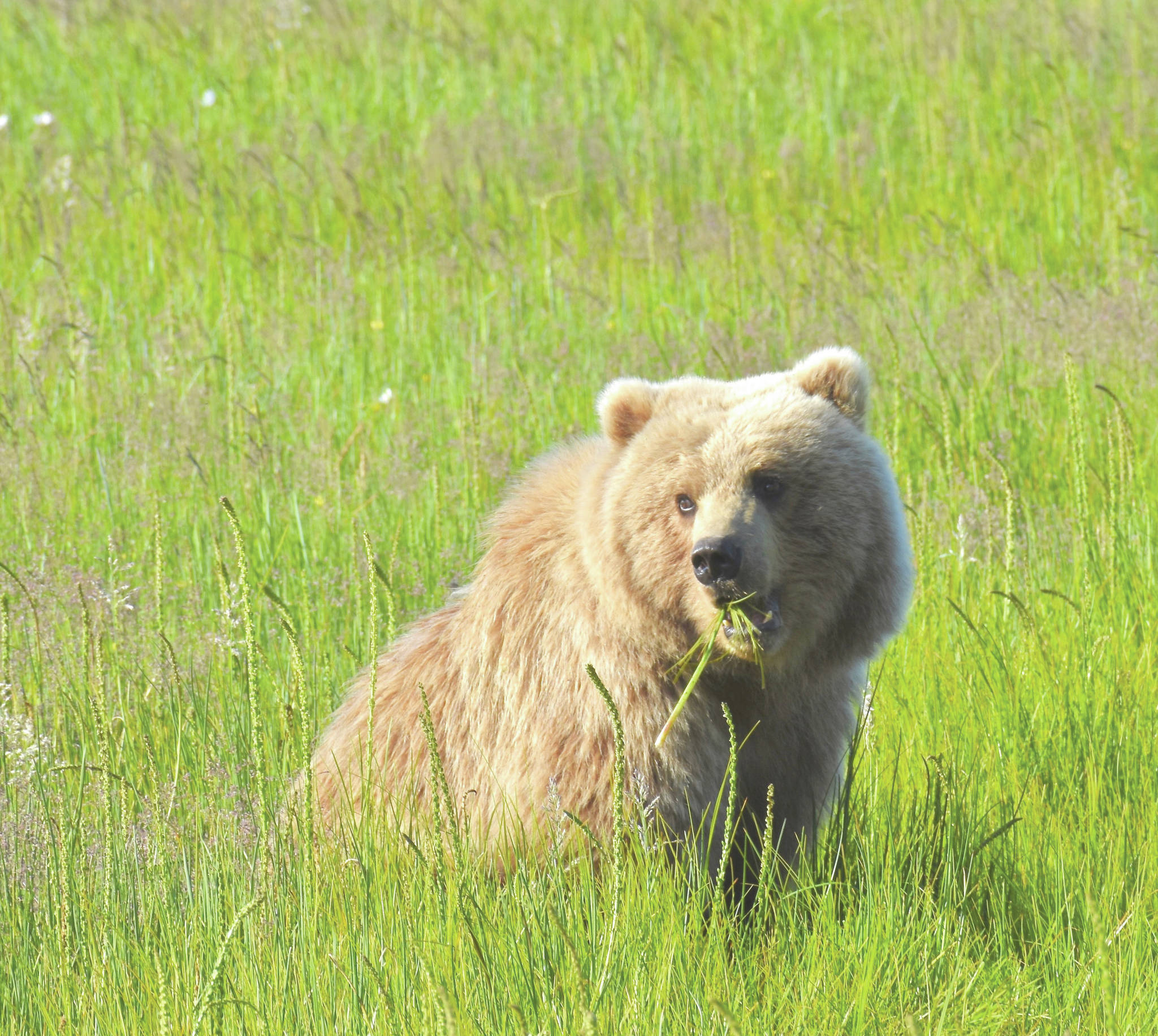Flying over the Cook Inlet coast, you can look down and see expansive salt marshes where mountain rivers meet the sea in lush green meadows. Heavily used by wildlife, these habitats are especially important to brown bears that use them for early season forage and mating.
Salt marshes are always changing. Scientists who monitor these salt marshes in Lake Clark and Katmai national parks and preserves wonder if changing marshes might benefit coastal brown bears.
Omnivorous and opportunistic feeders, brown bears eat a variety of plants and animals, including berries, sedges, herbs and roots; fish and shellfish; and mammals ranging from ground squirrels to moose. Brown bears are common along the southern coast of Alaska where they access an abundance of protein-rich foods, particularly salmon.
A coastal brown bear’s diet changes with the seasons.
Spring through midsummer, brown bears in Lake Clark and Katmai national parks and preserves can be found digging for clams on the tidal flats and feeding on sedges and other salt-tolerant plants in the extensive salt marshes. These food sources restore the bears’ depleted fat reserves between the time they emerge from their dens and when the salmon arrive.
A recent study from Katmai suggested that the majority of a coastal bear’s diet may consist of vegetation and that vegetation may have increased in importance as a food source over the last several decades. By mid to late summer, many bears move to the river mouths to feed on spawning salmon and into the adjacent forest to forage for berries.
Bear activity in the salt marsh appears to track timing of plant emergence and flowering. The window for foraging in meadows is short, because protein concentrations in the sedges decline over the course of the growing season, but during the spring and early summer months, the salt marshes serve as a living salad bar where bears can graze on young, nutrient-rich vegetation.
Bears tend to be most visible in the marshes and meadows early in the summer and in the cooler hours of the day. Aerial surveys conducted in Lake Clark National Park and Preserve over the past 18 years have recorded large fluctuations (up to a factor of 10) in bear counts in a single year, depending on meadow conditions.
As the summer progresses and the meadow forage becomes less palatable and nutritious, bears turn to other food sources. In warmer, drier years, when the vegetation begins to die back earlier, scientists have counted fewer bears in the midsummer.
The National Park Service monitors salt marsh vegetation in Lake Clark and Katmai to detect changes that may affect bears and the other resident species. Coastal marshes respond to a range of factors, including warming temperatures, storm surges, tectonic uplift and development-related activities.
Uplift in these areas following the 1964 earthquake resulted in the conversion of mudflats to sedge meadows and of wet meadows to areas of lowland shrubs. In some places, these formerly wet meadows now support young spruce that established shortly after 1964. Tectonic forces continue to gradually raise this coastline to this day.
Salt marsh monitoring began in the two parks in 2007 and 2008, and sites were surveyed again in 2018. Between the two points in time, the species present in the meadows remained largely unchanged.
However, we saw a widespread increase in the amount of vegetation, recorded as cover, across the sites, including an increase in the amount of many forage species used by bears (sedges and succulent forbs). The most dramatic changes in cover occurred on a few outer beach ridges and mud flats, which transitioned from barren mud or sand to dense meadow vegetation.
The increased cover observed in 2018 surveys suggests increased early season plant growth (productivity), possibly resulting from warming temperatures. In Katmai, cumulative growing degree days on July 1 — a measure of spring heat accumulation — increased by roughly one-third between 2008 and 2018.
Warming like this could result in an earlier start to the growing season and/or greater growth during the growing season, either of which could have resulted in more foliage and greater vegetative cover in recent years.
Both tectonic uplift and warming could have also led to drying in some of the wet meadows, where we have recorded an increase in upland species, including shrubs, at the meadow edges.
If changes in these salt marshes result in an earlier start to the growing season, or in greater vegetation growth, bears will likely benefit, but the story might not be that simple. If the salt marshes become more productive habitats, and particularly if they get drier, shifts in the species present in the meadows could lead to lower quality forage for bears.
Fortunately, we haven’t seen any signs of this occurring in these salt marshes. We will continue to monitor vegetation and bears in these valuable habitats, looking for more clues about what the future may hold. In the meantime, bears will continue to excel at what they do, seeking nourishment from the diverse array of resources that this wild coast provides.
Mike Hannam is an ecologist with the Southwest Alaska Inventory & Monitoring Network and leads monitoring efforts for salt marshes and vegetation in Katmai and Lake Clark national parks and preserve and Kenai Fjords National Park. Buck Mangipane is a wildlife biologist and the natural resources program lead for Lake Clark National Park and Preserve. Find more Refuge Notebook articles (1999–present) at https://www.fws.gov/refuge/Kenai/community/refuge_notebook.html.
By MIKE HANNAM and BUCK MANGIPANE
Refuge Notebook


